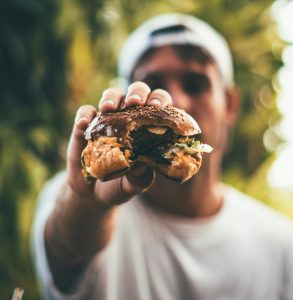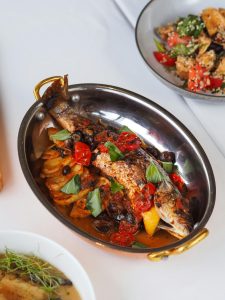6.3 Weder Fisch noch Fleisch – oder doch?

Servus!
Zum Aufwärmen machen wir unseren Tagesminiplausch und eine Wiederholung.
Wiederholung
In the previous lesson, you learned about vegetables and ways to describe the way vegetables are prepared. Let’s review what you have learned.
Isst du gern gesalzenes Gemüse? Isst du gern Gemüse mit Butter oder ohne Butter? Mit Sauce oder ohne Sauce? Consider the vegetables that you like to eat (choose at least two, if possible) and write in your written journal how you typically eat them.
Lektionsüberblick
We started this unit with the nutrient all-stars, fruits and veggies. Now it’s time to discuss the food products that we need for protein. In the end, you will be able to 1) name at least 5 kinds of eiweishaltige Lebensmittel, 2) say which kinds of eiweishaltige Lebensmittel you prefer to eat, and 3) say which kinds of preparation you prefer.
Was weißt du schon?
Let’s do a skills check before we dive in.
| Noch nicht start klar?
Du kannst immer auf die gleiche 1010-Lektion zurückgreifen! |
Not confident about starting this lesson?
You can always review the same Lektion from 1010. |
1) Eiweishaltige Lebensmittel kennen
Read and listen to the protein-rich foods in the presentation below. How many do you remember?
Let’s practice.
Jetzt bist du dran!
2) Lieber und am liebsten
We all have our preferences. Was isst du lieber? Was isst du am liebsten? Look at the examples.
 |
 |
 |
| Ich esse lieber Joghurt als Käse. | Ich esse lieber Hamburger als Tofu. | Ich esse am liebsten Forelle. |
Let’s practice.
Jetzt bist du dran!
Hamburg im Blickpunkt

Die Hanse war ein Zusammenschluss von Kaufleuten und Städten in Norddeutschland und Nordeuropa. Sie entstand im Mittelalter, um den Handel sicherer und erfolgreicher zu machen. Die Hanse-Mitglieder arbeiteten eng zusammen und schützten ihre Handelswege. Hamburg war ein zentraler Handelsplatz der Hanse wegen des großen Hafens. Im Laufe der Zeit verlor die Hanse an Bedeutung, aber ihre Spuren sieht man heute noch in den Namen der Städte wie die freie und Hansestadt Hamburg und die freie Hansestadt Bremen.
The Hanseatic League was an alliance of merchants and cities in northern Germany and northern Europe. It emerged in the Middle Ages to make trade safer and more successful. The Hanseatic members worked closely together and protected their trade routes. Hamburg was a central trading place of the Hanseatic League due to its major port. Over time, the Hanseatic League lost its importance, but its traces can still be seen in the names of cities like the Free and Hanseatic City of Hamburg and Free Hanseatic City of Bremen.
3) Zubereitung
How do you like your protein prepared? Gegrillt? Grilled? Gewürzt? Seasoned? The good news is that some of the descriptors we use to describe food preparation styles share similarities with English. Some you might have to look at a little closer to see a connection. Take a look. Be sure to click through to each page.
Read the example sentences below.
Ich esse lieber gebratenes als gebackenes Rindfleisch.
Ich esse am liebsten gegrillten Fisch.
Ich esse lieber gewürztes als ungewürztes Fleisch.
Ich esse scharfgewürzte Wurst am liebsten.
Ich esse lieber cremigen als fettarmen Joghurt.
Let’s practice.
Jetzt bist du dran!
Zum Schluß


*As you conclude this lesson, don’t forget to check Canvas!*

Media Attributions
- 1020-banner-large-reduced
- pexels-karolina-grabowska-6660117
- Photo of man with hamburger pexels-ollivves-1059040
- Photo of fish by pexels-nadin-sh-78971847-11776375
- all the proteins

